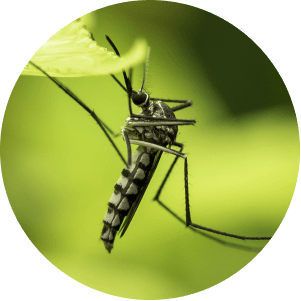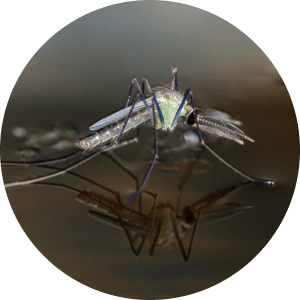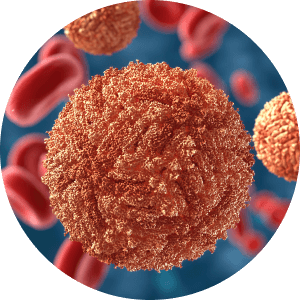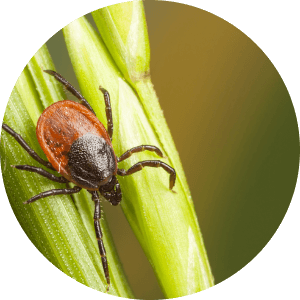Emerging & Re-emerging Disease Vaccines
vaccines
Diseases caused by newly emergent viruses, such as HIV, Ebola, SARS, MERS and SARS-CoV-2, result from increased contact with animals, often due to the expansion of the human habitat, and can lead to epidemics and pandemics. New vaccines that can be developed and deployed rapidly and reliably are a critical first line of defense against emerging and re-emerging disease outbreaks.
West Nile Virus
Coronavirus
Alphaviruses
Zika Virus
Tick-borne Flavivirus
West Nile Virus
Virtually unknown in the U.S. prior to 1999, the West Nile virus is now prevalent throughout the U.S. and Canada. While the majority of human infections result in mild to no symptoms, more severe forms of the disease can result in long term neuropathological effects and even fatalities. In mild cases flu-like symptoms are common. However, persistent encephalitis, meningitis, and polio-like symptoms are seen in more severe cases. Even mild cases can induce “long” complications with delayed symptoms after the initial infection has cleared.

Unlike many human viral diseases, West Nile causes both disease and death in animals as well. A well-validated animal model of human West Nile disease has been developed and we have conducted several studies using various formulations of Hawaii Biotech’s West Nile vaccine in this model. The results have shown that the vaccine provided 100% protection (all animals survived and remained healthy), while 50-75% of the control animals (animals not given vaccine) died or were sick. We maintain an IND on our recombinant subunit vaccine and have completed Phase 1 human clinical studies. This WNV vaccine was well tolerated at all doses tested and induced strong neutralizing antibody titers in these Phase 1 studies. We are currently working with The Access to Advanced Health Institute (AAHI) to produce clinical materials to evaluate a new vaccine formulation with the SLA-LSQ adjuvant.
Coronavirus
In the last 20 years there have been 3 significant coronavirus outbreaks that have greatly impacted global health. First, there was the Severe Acute Respiratory Syndrome (SARS) in 2002, then the Middle East Respiratory Syndrome (MERS) in 2012, and most recently a novel coronavirus in 2019, now officially named SARS-CoV-2 and the disease it causes is referred to as COVID-19. On March 11, 2020, as a result of the rapid global spread of the virus, the WHO declared that COVID-19 had reached pandemic levels. While there are now several licensed and EUA vaccines available for the prevention of severe COVID-19, the continued emergence of novel SARS-CoV-2 variants have necessitated the need to develop effective medical counter measures to effectively respond to the public health threat posed by this mutating virus.

In the development of coronavirus vaccines, it is important to carefully evaluate vaccine candidates in terms of safety as prior studies have identified concerns of enhanced disease as a result of skewed antibody responses that result in inflammatory alveolar damage. Our studies are designed to address these concerns through the design of subunits and the use of adjuvants that engender balanced Th1/Th2, or Th1 biased responses. The current recombinant subunit approach provides a means to deliver a safe, stable, and established manufacturing platform for a SARS CoV-2 vaccine.
The company together with collaborators at the the University of Texas Medical Branch (UTMB) is pursuing multiple coronavirus vaccine opportunities, including an individual novel S protein subunit for SARS-CoV-2 as a booster to other vaccines to increase the breadth and durability of the immune response. Additionally, we have developed a pan-beta coronavirus (sarbecoviruses) vaccine candidate has the potential to provide protection against SARS-CoV-1, SARS-CoV-2, and MERS, with a single formulation. We are also pursuing thermal-stable formulations for these vaccines candidates.
Alphaviruses
Viruses in the Alphavirus genus of the Togaviridae family pose a significant threat to humans. These arboviruses are transmitted by Aedes spp mosquitoes and are broadly divided into New World and Old World. New World viruses mostly cause encephalitic disease, while Old World viruses mostly cause arthritic disease. In the past 20 years, the Old World Chikungunya virus (CHIKV) has greatly expanded its geographic distribution and become a global health threat due to its high rate of infectivity and the severity of the disease it causes Estimates indicate that 1.3 billion people reside in areas at-risk for CHIKV transmission. As a result of this increase in range and number of human cases, CHIKV is considered a re-emerging pathogen; a contributing factor to this re-emergence is the adaptation to transmission by Aedes albopictus mosquitoes. In 2013, CHIKV emerged in the Americas and the World Health Organization reported in 2014 that there were over 1 million suspected cases of Chikungunya in the Caribbean islands and Central and South America. While the number of cases declined since this peak in 2014, the Pan American Health Organization (PAHO) recently reported that there was a 98% increase in cases 2022 and the trend appears to be carrying into 2023. Currently, there are no licensed vaccines or therapeutics to protect against CHIKV infection.

Together with collaborators at the Baylor College of Medicine, we have developed a promising recombinant subunit CHIKV vaccine that induces potent virus nAb responses that are able to prevent viral replication upon challenge of immunocompetent mice as well as protecting immunocompromised mice against lethal challenge. The role of antibodies in protection has been demonstrated in a passive serum transfer study which afforded complete survival of recipient immunocompromised mice. As with all vaccines, and in particular for priority pathogens such as CHIKV which requires BSL-3 handling, a combination of safety and economics in manufacturing are of paramount importance. Our recombinant subunit approach provides a means to deliver a safe, stable, and established manufacturing platform for a CHIKV vaccine.
Leveraging the results from our CHIKV recombinant subunit vaccine, we have extended this approach to the New World alphaviruses (NWAV), Venezuelan, eastern and western equine encephalitis viruses (VEEV, EEEV, and WEEV). These viruses are important human pathogens that cause varying levels of morbidity and mortality. There are currently no licensed vaccines to prevent disease caused by these viruses. Are approach to the NWAV is to develop a multivalent vaccine candidate that provides protection against all three viruses with a single formulation. Preliminary data supports this approach.
Zika Virus
Zika virus (ZIKV) is a mosquito-borne flavivirus that was originally isolated in 1947, and since that time has, caused sporadic outbreaks of mild disease in Africa, and Asia. Historically, symptoms associated with ZIKV infection were mild and so, until recently, the virus was not considered a significant public health issue. However, beginning with an outbreak in French Polynesia in 2013, infection with ZIKV has been associated with more severe neurological symptoms and birth defects. These more severe symptoms coupled with a dramatic spread of the virus throughout South and Central America, led to a declaration of ZIKV as a public health emergency by the World Health Organization (WHO). While multiple vaccine candidates have advanced to clinical trials, there is currently no licensed vaccine for ZIKV.

Our goal is to develop an optimize a ZIKV recombinant subunit vaccine candidate for rapid and durable immune responses. Initial studies demonstrated that the ZIKV protein with alum can protect non-human primates against viremia. We have investigated a number of other adjuvants, to include synthetic TLR-4 agonists, for use in clinical studies.
Tick-borne Flavivirus
The tick-borne flavivirus (TBFV) group includes a number of important human pathogens that result in serious neurological or hemorrhagic diseases. The TBFVs are considered to be emerging or re-emerging pathogens due to increases in the number of human infections, the expansion of their geographic distribution, and emergence of new viruses. Due to the number of different mammalian TBFVs and the expansive geographic areas that they cover, the ability to provide effective protection against this group is challenging. Inactivated vaccines are available for protection against the three tick-borne encephalitis (TBE) viruses. These vaccines are monovalent and only provide protection against the TBE subtypes and there is a growing need for protection against viruses such as Powassan virus (POWV) and the TBFVs that cause hemorrhagic fever. One solution for a group of viruses such as TBFV, is to develop multivalent vaccines that induce broad cross-protective immunity against multiple viruses.

We have developed a very promising multivalent mammalian TBFV vaccine candidate composed of recombinant subunit envelope proteins from three viruses in this group. Together with collaborators at the University of Texas Medical Branch, we have demonstrated that the multivalent vaccine induces broad cross-protection in mouse challenge studies against five of the major mammalian TBFV’s. The role of antibodies in protection have also been confirmed by challenge studies following passive transfer of serum from immune animals. The safety of the multivalent vaccine formulation that includes the adjuvant SLA-LSQ has been demonstrated in GLP toxicology studies. Efforts are underway to complete preclinical activities to include cGMP manufacturing to support clinical evaluation of novel vaccine candidate.
West Nile Virus
West Nile Virus
Virtually unknown in the U.S. prior to 1999, the West Nile virus is now prevalent throughout the U.S. and Canada. While the majority of human infections result in mild to no symptoms, more severe forms of the disease can result in long term neuropathological effects and even fatalities. In mild cases flu-like symptoms are common. However, persistent encephalitis, meningitis, and polio-like symptoms are seen in more severe cases. Even mild cases can induce “long” complications with delayed symptoms after the initial infection has cleared.

Unlike many human viral diseases, West Nile causes both disease and death in animals as well. A well-validated animal model of human West Nile disease has been developed and we have conducted several studies using various formulations of Hawaii Biotech’s West Nile vaccine in this model. The results have shown that the vaccine provided 100% protection (all animals survived and remained healthy), while 50-75% of the control animals (animals not given vaccine) died or were sick. We maintain an IND on our recombinant subunit vaccine and have completed Phase 1 human clinical studies. This WNV vaccine was well tolerated at all doses tested and induced strong neutralizing antibody titers in these Phase 1 studies. We are currently working with The Access to Advanced Health Institute (AAHI) to produce clinical materials to evaluate a new vaccine formulation with the SLA-LSQ adjuvant.
Coronavirus
Coronavirus
In the last 20 years there have been 3 significant coronavirus outbreaks that have greatly impacted global health. First, there was the Severe Acute Respiratory Syndrome (SARS) in 2002, then the Middle East Respiratory Syndrome (MERS) in 2012, and most recently a novel coronavirus in 2019, now officially named SARS-CoV-2 and the disease it causes is referred to as COVID-19. On March 11, 2020, as a result of the rapid global spread of the virus, the WHO declared that COVID-19 had reached pandemic levels. While there are now several licensed and EUA vaccines available for the prevention of severe COVID-19, the continued emergence of novel SARS-CoV-2 variants have necessitated the need to develop effective medical counter measures to effectively respond to the public health threat posed by this mutating virus.

In the development of coronavirus vaccines, it is important to carefully evaluate vaccine candidates in terms of safety as prior studies have identified concerns of enhanced disease as a result of skewed antibody responses that result in inflammatory alveolar damage. Our studies are designed to address these concerns through the design of subunits and the use of adjuvants that engender balanced Th1/Th2, or Th1 biased responses. The current recombinant subunit approach provides a means to deliver a safe, stable, and established manufacturing platform for a SARS CoV-2 vaccine.
The company together with collaborators at the the University of Texas Medical Branch (UTMB) is pursuing multiple coronavirus vaccine opportunities, including an individual novel S protein subunit for SARS-CoV-2 as a booster to other vaccines to increase the breadth and durability of the immune response. Additionally, we have developed a pan-beta coronavirus (sarbecoviruses) vaccine candidate has the potential to provide protection against SARS-CoV-1, SARS-CoV-2, and MERS, with a single formulation. We are also pursuing thermal-stable formulations for these vaccines candidates.
Alphaviruses
Alphaviruses
Viruses in the Alphavirus genus of the Togaviridae family pose a significant threat to humans. These arboviruses are transmitted by Aedes spp mosquitoes and are broadly divided into New World and Old World. New World viruses mostly cause encephalitic disease, while Old World viruses mostly cause arthritic disease. In the past 20 years, the Old World Chikungunya virus (CHIKV) has greatly expanded its geographic distribution and become a global health threat due to its high rate of infectivity and the severity of the disease it causes Estimates indicate that 1.3 billion people reside in areas at-risk for CHIKV transmission. As a result of this increase in range and number of human cases, CHIKV is considered a re-emerging pathogen; a contributing factor to this re-emergence is the adaptation to transmission by Aedes albopictus mosquitoes. In 2013, CHIKV emerged in the Americas and the World Health Organization reported in 2014 that there were over 1 million suspected cases of Chikungunya in the Caribbean islands and Central and South America. While the number of cases declined since this peak in 2014, the Pan American Health Organization (PAHO) recently reported that there was a 98% increase in cases 2022 and the trend appears to be carrying into 2023. Currently, there are no licensed vaccines or therapeutics to protect against CHIKV infection.

Together with collaborators at the Baylor College of Medicine, we have developed a promising recombinant subunit CHIKV vaccine that induces potent virus nAb responses that are able to prevent viral replication upon challenge of immunocompetent mice as well as protecting immunocompromised mice against lethal challenge. The role of antibodies in protection has been demonstrated in a passive serum transfer study which afforded complete survival of recipient immunocompromised mice. As with all vaccines, and in particular for priority pathogens such as CHIKV which requires BSL-3 handling, a combination of safety and economics in manufacturing are of paramount importance. Our recombinant subunit approach provides a means to deliver a safe, stable, and established manufacturing platform for a CHIKV vaccine.
Leveraging the results from our CHIKV recombinant subunit vaccine, we have extended this approach to the New World alphaviruses (NWAV), Venezuelan, eastern and western equine encephalitis viruses (VEEV, EEEV, and WEEV). These viruses are important human pathogens that cause varying levels of morbidity and mortality. There are currently no licensed vaccines to prevent disease caused by these viruses. Are approach to the NWAV is to develop a multivalent vaccine candidate that provides protection against all three viruses with a single formulation. Preliminary data supports this approach.
Zika Virus
Zika Virus
Zika virus (ZIKV) is a mosquito-borne flavivirus that was originally isolated in 1947, and since that time has, caused sporadic outbreaks of mild disease in Africa, and Asia. Historically, symptoms associated with ZIKV infection were mild and so, until recently, the virus was not considered a significant public health issue. However, beginning with an outbreak in French Polynesia in 2013, infection with ZIKV has been associated with more severe neurological symptoms and birth defects. These more severe symptoms coupled with a dramatic spread of the virus throughout South and Central America, led to a declaration of ZIKV as a public health emergency by the World Health Organization (WHO). While multiple vaccine candidates have advanced to clinical trials, there is currently no licensed vaccine for ZIKV.

Our goal is to develop an optimize a ZIKV recombinant subunit vaccine candidate for rapid and durable immune responses. Initial studies demonstrated that the ZIKV protein with alum can protect non-human primates against viremia. We have investigated a number of other adjuvants, to include synthetic TLR-4 agonists, for use in clinical studies.
Tick-borne Flavivirus
Tick-borne Flavivirus
The tick-borne flavivirus (TBFV) group includes a number of important human pathogens that result in serious neurological or hemorrhagic diseases. The TBFVs are considered to be emerging or re-emerging pathogens due to increases in the number of human infections, the expansion of their geographic distribution, and emergence of new viruses. Due to the number of different mammalian TBFVs and the expansive geographic areas that they cover, the ability to provide effective protection against this group is challenging. Inactivated vaccines are available for protection against the three tick-borne encephalitis (TBE) viruses. These vaccines are monovalent and only provide protection against the TBE subtypes and there is a growing need for protection against viruses such as Powassan virus (POWV) and the TBFVs that cause hemorrhagic fever. One solution for a group of viruses such as TBFV, is to develop multivalent vaccines that induce broad cross-protective immunity against multiple viruses.

We have developed a very promising multivalent mammalian TBFV vaccine candidate composed of recombinant subunit envelope proteins from three viruses in this group. Together with collaborators at the University of Texas Medical Branch, we have demonstrated that the multivalent vaccine induces broad cross-protection in mouse challenge studies against five of the major mammalian TBFV’s. The role of antibodies in protection have also been confirmed by challenge studies following passive transfer of serum from immune animals. The safety of the multivalent vaccine formulation that includes the adjuvant SLA-LSQ has been demonstrated in GLP toxicology studies. Efforts are underway to complete preclinical activities to include cGMP manufacturing to support clinical evaluation of novel vaccine candidate.

